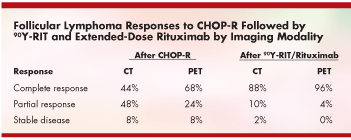Zevalin/R after CHOP-R doubles CRs in follicular NHL
Among patients with follicular non-Hodgkin's Lymphoma (F-NHL), adding 90yttrium-ibritumomab tiuxetan (Zevalin) plus extended-dose rituximab (Rituxan) to a short course of CHOP plus rituximab (CHOP-R) increased complete response rates with acceptable toxicity
ASCO-Among patients with follicular non-Hodgkin's Lymphoma (F-NHL), adding 90yttrium-ibritumomab tiuxetan (Zevalin) plus extended-dose rituximab (Rituxan) to a short course of CHOP plus rituximab (CHOP-R) increased complete response rates with acceptable toxicity, according to phase II clinical trial results presented at the 43rd Annual Meeting of the American Society of Clinical Oncology (abstract 8005).
Rachel C. Jankowitz, MD, reported the study, led by Samuel Jacobs, MD, in which 60 F-NHL patients received CHOP (cyclophosphamide, doxorubicin, vincristine, prednisone) plus rituximab every 3 weeks for three cycles, followed by 90yttrium-ibritumomab tiuxetan radioimmunotherapy (90Y-RIT) and then rituximab weekly for 4 weeks. Dr. Jankowitz is a fellow in the Department of Hematology/Oncology at the University of Pittsburgh Cancer Centers.
The intent was to minimize chemotherapy toxicity and maximize complete response rates. The primary endpoint was complete response, determined by CT and PET imaging.
Included patients had grade 1-3 follicular NHL, had received no prior chemotherapy or monoclonal antibody therapy, had bulky tumors (greater than 5 cm) or symptomatic stage II-IV disease, and ECOG performance status 0-2.
Of 56 evaluable study patients, 50 had completed the full treatment regimen and were evaluated for response, with a median follow-up of 14.5 months.
Responses to therapy varied according to the imaging modality (see Table). The complete response rate as determined by CT scan rose from 44% after completion of three cycles of CHOP-R to 88% after 90Y-RIT and extended-dose rituximab. As determined by PET imaging, the rates were 68% and 96%, respectively. The overall response rate by CT was 92% after CHOP-R and 100% after 90Y-RIT/rituximab.
Dr. Jankowitz pointed out that a significant number of patients who had a partial response by PET after CHOP-R (12 patients) became complete responders after 90Y-RIT, giving an overall comoplete response rate of 96% by PET after 90Y-RIT/rituximab.
Among the 56 evaluable patients, 1-year progression-free survival was 98% and 2-year progression-free survival was 77%, indicating the potential for long-term remissions, Dr. Jankowitz commented.
Of the five patients who relapsed, all had stage IV disease at entry and all had failed to achieve PET negativity after CHOP-R (P = .002), suggesting that PET positivity may signal greater risk of relapse, Dr. Jankowitz said.

Adverse Events
Almost half (49%) of patients had a grade 3 or higher toxicity as their worst grade adverse event during the CHOP-R phase (54% during the 90Y-RIT phase). One patient died of a GI bleed during CHOP-R and another of neutropenic fever and sepsis.
Grade 3-4 neutropenia occurred in 43% of patients in the CHOP-R phase and 40% in the 90Y-RIT phase. However, grade 3-4 febrile neutropenia was reported in only 7% and 2%, respectively. Grade 4 thrombocytopenia occurred in 18% of the 90Y-RIT patients (0% in CHOP-R), but there were no major bleeding complications and only a 10% transfusion rate.
The majority of 90Y-RIT toxicities, Dr. Jankowitz noted, were asymptomatic hematologic laboratory abnormalities.
Newsletter
Stay up to date on recent advances in the multidisciplinary approach to cancer.
Highlighting Insights From the Marginal Zone Lymphoma Workshop
Clinicians outline the significance of the MZL Workshop, where a gathering of international experts in the field discussed updates in the disease state.